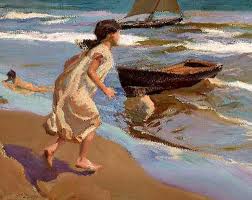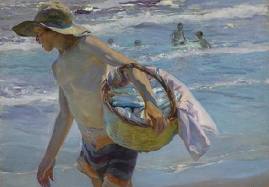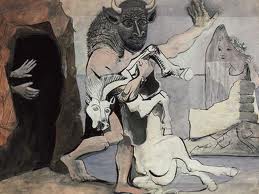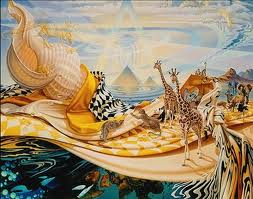Spanish Painting Modern Period
As the centuries went by, Spanish painters began moving away from the traditional styles of painting, towards more abstract and freer styles of paintings. Subjects began to become more obscure, reaching its height in the Surrealist movement. The 20th Century was probably one of the richest centuries in terms of successful and world famous Spanish artists. This century was the time of Picasso, Dalí and Gris, among others, who all left a significant impression on the world of Spanish art.
Impressionist Spanish Painting

Impressionism originated in Paris in the latter part of the 19th Century, in the 1860s and 1870s, although it was never very successful then, as it was not approved of by the French Academy of Fine Arts. However today, the Impressionists' paintings are world famous.
Impressionist paintings consisted in quick, loose brushstrokes and their main focus was the realistic impression of light falling on the subjects and objects of the painting. Impressionist painters would often paint without studying a subject, but would simply sketch and paint, allowing themselves complete artistic freedom.
The majority of the celebrated Impressionist painters came from France, where the style had developed. Claude Monet, Paul Cezanne and Edouard Manet were all French Impressionists. However, Spain had its own brand in the form of Joaquín Sorolla from Valencia.
Sorolla painted many fantastic representations of Spanish people under the Spanish sun. His most famous works include 'Sad Inheritance' (Triste herencia) and 'Portrait of Dr Simarro at the Microscope' (el Dr Simarro en el laboratorio).
Symbolist Spanish Painting

Symbolism was an artistic movement that spanned all types of art during the start of the 20th Century, particularly in the domains of poetry and literature. However it also made its way into Spanish painting.
Symbolist paintings, obviously, used a lot of symbols along side dream and mythical like imagery to convey the feelings and emotions of the painter. This therefore meant that the symbols used in the paintings were very personal to the painter, rather than common or well known imagery that everyone could recognise. Symbolist paintings are therefore frequently very mysterious for the audience.
The Spanish painter from the Canary Islands, Néstor Martín-Fernández de la Torre, was a particularly famous Spanish Symbolist and Modernist painter, whose work is critically acclaimed in Spain.
Cubist Spanish Painting

Cubism was a revolutionary style of painting, developed principally by Spanish painter Pablo Picasso, originally from the city of Málaga, at the beginning of the 20th Century. Cubism uses geometrical shapes in order to create a picture. Cubism is said to have been the end of realistic paintings, and the dawn of Modern Art.
There can be no doubt that the most important Cubist painter was the Spaniard, Pablo Picasso, who has been described as the Father of the entire Cubist movement. Yet other important Cubist painters include Georges Braque and Juan Gris.
Picasso's most famous works include 'Guernica', 'Les Demoiselles d'Avignon' and 'The Weeping Woman'. 'Guernica' is particularly important in Spanish culture due to its relation to the Spanish Civil War.
Surrealist Spanish Painting

Surrealism was an art form that was particularly popular during the period between the two World Wars. It was a kind of anti-art that specialised in representing the images of the unconscious mind. Due to this focus on the 'dream-like' images, Surrealism included many different techniques and styles. For its part, Spain has produced many great Surrealist painters, each of them with their own distinct style of Surrealism and their own completely different personalities.
The eccentric Salvador Dalí, often remembered for his wild moustache, painted many dream inspired paintings such as 'The Persistence of Memory' (La persistencia de la memoria) and 'Soft Construction with Boiled Beans (Premonition of Civil War)' (Construcción blanda con judias hervidas (Premonición de la guerra civil)).
Joan Miró was another Spanish painter who used the Surrealism style. Miró experimented in Early Surrealism and Surrealist Pictorial Language painting. 'The Tilled Field' (La terre labourée) and 'Blue I, II, and III' are just some of his many great works.
